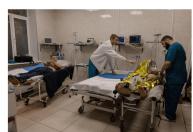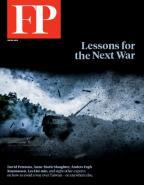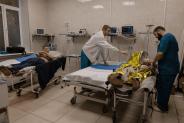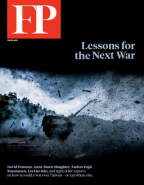新闻集(含内容及图片)
2023 年 4 月 7 日 第 445 空运联队飞行员参加全力创伤护理训练
2023 年 6 月 1 日 第934空运联队组织联合部队训练演习
2023 年 7 月 7 日 KC-135 作为在德国和荷兰执行多项任务的平台
2023 年 7 月 7 日 飞行员参加联合CCATT训练
2023 年 7 月 19 日 空军预备役 AE 技术人员与秘鲁合作伙伴参加场景训练
2023 年 7 月 13 日 飞行员、盟国和合作伙伴在 2023 年“机动卫士”期间进行医疗准备培训
2023 年 7 月 20 日 当时间紧迫时,AE 团队会及时赶到
2023 年 8 月 1 日 C-STARS 获得了用于传染病准备训练的新设备
2023 年 8 月 1 日 横田医疗队在 2023 年移动卫士期间与盟友测试应急响应
2023 年 8 月 14 日 医务人员在应急响应制定过程中接受培训
美国陆军第 82 空降师和乌克兰第 80 空中机动师的伞兵从 C-17 环球霸王 III 上降落伞
12-乌克兰医务人员在前线俄罗斯乌克兰战争乌克兰医务人员的故事英语新闻
士兵们:医务人员是如何撤离的
2023年3月23日 乌克兰军事护理人员撤离一名受伤的军人 巴赫穆特附近的前线。
2023年7月18日乌克兰的军队:如何拯救他们 更多的士兵
乌克兰东部前线的战斗医务人员
乌克兰正在建造一支先进的无人机军队
康涅狄格州陆军卫队医护人员在大规模伤亡训练中证明了他们的能力
来自“森林中的革命医院”-前线医生的日记-缅甸边境
来自巴克穆特北部前线的报道——更多的战争爆发——《旗帜报》
德国为乌克兰士兵提供免费医疗的承诺遇到了官僚主义障碍
在前线附近的乌克兰临时医院里-独立报
军事医学正在为下一场冲突做准备
在乌克兰南部前线附近,医护人员冒着火箭为士兵治疗
在他们自己的前线——自反攻开始以来,乌克兰外科医生治疗了一波又一波的士兵——科罗拉多哨兵
乌克兰外科医生在他们自己的前线-俄乌战争-半岛电视台
乌克兰医务人员在前线的最新消息
对一线医护人员施加的压力 乌克兰反击
乌克兰战争的教训及其在未来与近邻对手冲突中的应用——PMC
纪念33岁的皮特·里德,一名在乌克兰牺牲的前线人道主义医务人员
“第二次俄乌战争”——政策报告——RAS_NSA
国家元首访问了巴克穆特地区受伤的守军正在接受治疗的稳定点
作为一名战斗医务人员的潜在危险-创伤后应激障碍-前线反应服务
今天的D简报-更多的导弹击中乌克兰-巴赫穆特前后的照片
乌克兰医务人员在波兰的培训进入新阶段-
美国医务人员必须从乌克兰战争中学习-报告说- JEMS- EMS-紧急医疗服务-培训-护理人员- EMT新闻
乌克兰首次在战场上用大型无人机疏散受伤士兵
乌克兰军队在英国接受战斗医疗训练——面临战场医疗人员严重短缺的国家——日本新闻
乌克兰使用无人机疏散受伤士兵-报告
乌克兰战争-认识一下被炸弹和子弹打伤的医生和护士
乌克兰女医务人员和机枪手人数创历史新高——《华盛顿邮报》
乌克兰——在巴赫穆特附近的一家前线医院里——开放民主
乌克兰的医务人员发动了他们自己的战争,因为进攻方的推进给他们带来了更多的伤员
乌克兰的志愿医生用医院营的大巴从东部前线疏散士兵-
乌克兰一线医护人员每天都面临生死抉择
乌克兰军医在前线奋力抢救生命-俄乌战争新闻-半岛电视台
乌克兰军医在前线附近奋力拯救生命——福克斯新闻
乌克兰军队医务人员在前线拯救生命
乌克兰军队医务人员在前线拯救生命
乌克兰战地医生透露她在乌克兰顿巴斯工作的细节_乌克兰新之声
乌克兰外科医生获得军事医学速成班-或管理新闻
本科生与北约的合作伙伴 减少战斗伤亡
-乌克兰战争-无国界医生组织(msf)
乌克兰血腥的战场教给医护人员的是什么
双子城的康复工作帮助乌克兰人从战争中恢复过来 - 乌克兰 - 新闻中心 救济网
陆军预备役战斗医务人员初级创伤护理经验是一种新途径吗_
外科医生看到一波受伤反进攻后的士兵
一线医务人员的自白
乌克兰的战争——从医生和医疗志愿者的角度看——The Week
俄乌的可转移军事医学经验
乌克兰的血腥战场是教医务人员
乌克兰的军事医学是一个关键的优势
乌克兰军事医学是对抗俄罗斯的关键优势
乌克兰血腥的战场教给医护人员的是什么
乌克兰战争中,俄罗斯在最近的导弹袭击中摧毁了一家医院
在俄罗斯炮火下——一名乌克兰士兵撤离伤员——
我所做的就是治疗伤员”-认识一下为与俄罗斯作战的士兵做手术的乌克兰外科医生
第138战斗机联队医疗飞行员前往伤员救护中心
1000名乌克兰病人被转移到欧洲医院
-俄罗斯-乌克兰战争直播:“判断乌克兰夏季攻势是否失败还为时过早” 乌克兰 _ 守护者
将把饱受战争蹂躏的乌克兰病人运送到挪威医院
乌克兰的火车是连接首都和前线的生命线
乌克兰前线维持医疗保健并完成贫困努力
乌克兰前线志愿救护人员阿富汗士兵
隐藏俄罗斯伤亡人员的医院内部
美国志愿医务人员在摩苏尔战斗中救治伤员
在乌克兰战争中,夫妻医生团队经营前线医院
深入了解乌克兰士兵在艰苦的反攻前线的情况
医生在医院治疗受伤的乌克兰军人
乌克兰无国界医生组织报道了俄罗斯的所作所为
欧盟和世卫组织联手进一步加强乌克兰的医疗后送行动
将远程医疗的好处扩展到乌克兰的战争中
乌克兰武装部队的医生
来自前线“我和所有这些士兵都很亲近”
乌克兰一线医护人员面临迫在眉睫的心理健康危机
在俄罗斯各地区开设医疗保健中心
乌克兰前线诊所内,据称俄罗斯集束炸弹袭击造成大屠杀
拯救乌克兰的生命
为乌克兰战争伤员提供物理治疗
数百万人逃离乌克兰战争
俄罗斯医院“简化”战斗伤害以将士兵送回战场
超级细菌在乌克兰战争的战壕中站稳了脚跟
以从俄罗斯手中夺回被俘的巴赫穆特——野蛮的入侵仍在继续
女性志愿者治疗乌克兰前线部队
德国美军医院治疗在乌克兰战斗中受伤的美国人
乌克兰和波兰建立军事医疗中心
乌克兰军医依靠信仰和天性治愈战争创伤
乌克兰外科医生整天给士兵做手术
乌克兰战争和抗菌素耐药性
乌克兰军医在前线奋力抢救生命
乌克兰军医在前线拯救生命
乌克兰医院加班加点,创伤列车疏散战争伤员
乌克兰士兵在前线附近学习急救
乌克兰兽医学会用尸体战争导航世界
志愿医护人员从乌克兰前线疏散受伤士兵
在乌克兰南部前线附近,医护人员冒着火箭的危险治疗士兵
俄罗斯一入侵,我们就开始看到伤员”
乌克兰武装部队的战斗药物:如何拯救更多的士兵
乌克兰的苏格兰医生在俄罗斯入侵中拯救生命
改造后的美国陆军药房准备训练课程增强了未来作战行动的部队保障
美国国防部 MHS GENESIS 部署完成
美军如何让部队适应高空作战
新的“医疗模拟和生物技能中心”在勒琼营海军医疗中心开业
虚拟教育中心为患者提供健康信息
叙利亚称其挫败了以色列黎明前对大马士革乡村的袭击
新闻集 视频类
12-乌克兰医务人员在前线俄罗斯乌克兰战争乌克兰医务人员的故事英语新闻
13-乌克兰战争在一所戒备森严的医院里,满是受伤的士兵
14-在乌克兰的绞肉机城市巴赫穆特,医务人员总是很可怕
15-在顿涅茨克地区,军医如何在前线救治受伤士兵
16-在乌克兰战地医院的一天
17-乌克兰的军事医院遭受战争的影响
19-在乌克兰前线医院的边缘
20-顿巴斯前线医护人员一天的生活
21-在乌克兰战地医院的一天
22-“22号计划”帮助乌克兰医院应对大规模伤亡事件
23-乌克兰一线医护人员的一天
24-一名乌克兰医务人员在战争前线的故事
26-在乌克兰前线的医院里
27-乌克兰前线医护人员如何治疗伤员
28-我只做战争期间的乌克兰外科医生
29-前线医院——西方坦克不能很快赶到
18-乌克兰军队摧毁了俄罗斯军队和武装分子
30-怎样才能成为军队中最好的医生
31-在乌克兰境内,一支旅正在“穿越地狱”,夺回通往巴克穆特的一个村庄
32-俄罗斯士兵在穿越铁路后被乌克兰军队伏击
33-法国空军飞行员在军事演习中分享经验
34-治疗被控袭击战地医院的俄罗斯士兵
35-乌克兰外科医生面对一波又一波的伤兵
36-乌克兰医护人员的随身摄像头显示了战争的恐怖
37-乌克兰战争前线医院治疗乌克兰士兵
38-乌克兰战争在一所戒备森严的医院里,满是受伤的士兵
39-乌克兰战争中的瑞典312医疗部队
40-在乌克兰稳定点前线拯救生命
42-在线考试-前线服务乌克兰医务战争
43-在战争前线运营的乌克兰野战医院
13-乌克兰战争在一所戒备森严的医院里,满是受伤的士兵
14-在乌克兰的绞肉机城市巴赫穆特,医务人员总是很可怕
15-在顿涅茨克地区,军医如何在前线救治受伤士兵
16-在乌克兰战地医院的一天
17-乌克兰的军事医院遭受战争的影响
18-乌克兰军队摧毁了俄罗斯军队和武装分子
19-在乌克兰前线医院的边缘
-
+
首页
乌克兰军事医学是对抗俄罗斯的关键优势
乌克兰的军事医学是一种 关键优势  俄罗斯过时的训练和 装备是士兵的代价 他们的生命 由塔尼沙M。法扎尔说,该大学的政治学教授 一名麻醉师准备在一家医院接受军事病人的治疗 乌克兰顿涅茨克区,10月10日。9. 一名麻醉师准备在一家医院接受军事病人的治疗 乌克兰顿涅茨克区,10月10日。9.宝拉布朗斯坦/盖蒂图片 我的FP:关注主题和作者,直接了解你喜欢的内容。 仅供FP订户使用。现在就订阅|,请登录 2022年10月31日,下午1:10 俄罗斯对乌克兰的持续入侵已经花费了100多美元 自2月份以来提供了数十亿美元的援助,联合国的几次投票 从美国转让或出售高科技武器系统 包括HIMARS火箭发射系统, 开关刀片600无人机,和手垫防空系统。但是 西方对乌克兰的援助的另一个更平淡的部分是 对冲突的重大影响:医疗用品。军事医学是 这在很大程度上被忽视了对军事效力的贡献者,但它的影响 都在战场上实时上演。 从更好的现场卫生到机械化和空气疏散 作为现代的防弹衣,今天的军队会利用这些武器 改变不仅可以拯救生命,而且还可以保持他们的力量 力例如,在第一次世界大战中,受伤的美国士兵。S.士兵们可以等待 被疏散到几英里外的野战医院的时间;在期间 相比之下,阿富汗战争使美国人受伤。S.军人 将被疏散到美国。位于德国兰德斯图尔的军事医院, 甚至在一两天内回到美国。  本文发表在2023年冬季出版的《外交政策》杂志上 杂志探索这个问题。 大家都说,乌克兰的军事药物要比俄罗斯好得多。 例如,乌克兰军队在战术战斗方面受过良好的训练 伤亡护理(TCCC) ,一套院前指南,由 U.S.20世纪90年代,早期修订和广泛采用 多年的阿富汗和伊拉克战争。U.S.军事医疗 医生发现,87%的可预防的战斗死亡 发生在院前环境中;其中,迄今为止最多的是 死于出血。因此,TCCC的指南非常关注 出血,并建议何时使用止血带,止血剂 用敷料和夹子来防止失血。来自西方的援助已经到位 包括这些用品,以及相关设备 比如防弹衣。西方国家的顾问们也一直在推动 在远距离前进的环境中使用全血。乌克兰的一个原因 医疗上的优势是,它不仅此后欢迎这种援助 但在过去的八年里。 自从入侵克里米亚以来 2014年,乌克兰一直在准备与俄罗斯发动全面战争,其中包括 在医疗方面。 另一方面,俄罗斯军队,缺乏医疗训练,以及 日用品据报道,最近的一段视频在社交媒体上被广泛分享 显示俄罗斯军官要求新应征士兵购买卫生棉条 塞子弹的伤口。俄罗斯一直面临军事短缺 多年的医疗人员配备。据报道,俄罗斯人的士气也很低, 从现场报告和俄罗斯人的流动中都可以看出 这是一个国家,以便不应征入伍。士气低落的原因之一 是否可能有关于医疗保健和供应不足的报告,包括使用这些药物的情况 苏联时代的急救儿童和有限的药品。而俄罗斯 工作人员在TCCC接受过一些培训,他们似乎缺乏关键的培训 现代装备,如战斗应用止血带 实施这些指导方针。 更好的军事医学在战场上至少有三个问题 理由首先,有更好的药物意味着拯救更多的生命;在其他 言语上说,军队有更好的药物可以带来更多的人 与…作斗争在战争开始时,他们很可能会更健康 平等的,将更有可能接受允许他们接受的治疗 他迟早会返回工作岗位。 第二,有更好的药物治疗意味着更高的可能性 保持单位的凝聚力;而不是被送回家(或者更糟的是, 受伤的士兵可以接受治疗并被送回他们的部队。社交 债券可以维持。新部队不必集结 训练第三,更好的药物治疗意味着提高军队的士气。 知道你和你的战友们会得到良好的治疗 在生病或受伤时的护理会让你更愿意战斗 并承担风险。这意味着一个国家不愿浪费其士兵的生命 ——与俄罗斯大众的态度形成了鲜明对比 动员经常未经训练的士兵。 这些因素在美国最近的研究中都很明显 在阿富汗和伊拉克的战争。2004年建立了一个创伤登记处 促进了军事医疗数据收集方面的一场革命 转向,允许研究的基础指南,如TCCC。这个 对阻止失血量的强烈关注导致了该发明和使用 新型止血带、止血敷料和导管 维持血液流动。并理解它的关键重要性 尽快提供护理促使美国。S.国防部长 罗伯特 ·盖茨在2009年实施了“黄金时间 ”规则 任何受伤的美国。S.军事人员将被疏散到更高的级别 在受伤的第一个,最关键的一个小时内。组合, 这些变化使美国的伤员增加了两倍 在伊拉克行动中,从传统的3:1到10:1 自由和持久的自由。 当然,这些战争在很多方面都是不可比拟的。 一个关键的区别是,美国打击了反叛叛乱 在阿富汗和伊拉克。至少到目前为止,俄罗斯之间的冲突 乌克兰是一场传统的战争,更让人想起过去的土地 在欧洲的战争中, 以及一致的伤亡水平。而不是炮兵 比路边炸弹一直是造成伤害的主要机制。另一个 重要的对比与空中疏散有关,这是节约的关键部分 伤员的生命。乌克兰和俄罗斯都没有空中优势 在这场战争。因此,医疗后送受到了影响,尽管乌克兰 战斗更接近自己的领土和普遍优越 后勤考虑到即时护理的重要性 生存,有限的医疗治疗有助于理解惊人的低 对俄罗斯人的伤亡比例的估计值为3:1。 同时,也有重要的相似之处,包括在周围 报告伤亡人数的政治观点。可用的最佳估计数 例如,俄罗斯人的伤亡人数并不是来自俄罗斯人的。相反 北约和各西方情报机构一直在进行报告 这些数字。乌克兰自己的伤亡报告一直很少 最好的两国不愿报告的部分原因 伤亡是因为这样的报告会降低士气,包括 在军队中,但也在国内。这种做法对 著名的“多佛效应 ”,指的是军用棺材的图像 在多佛空军基地悬挂着美国国旗 美国但伤亡报告也是如此 成为信息战运动的一部分。乌克兰 例如,战争第一天就有1000名俄罗斯人死亡, 而俄罗斯媒体则声称,乌克兰已经损失了4000人 9月的一个星期。 实际的伤亡人数,尤其是在乌克兰方面 由于俄罗斯针对乌克兰的医院而增加 违反国际法除了打击平民医疗人员之外 基础设施, 比如3月份的妇产医院 该部队还瞄准了乌克兰的医疗后送铁路线。 然而,所有迹象都表明,乌克兰在医疗上拥有优势 在这场战争。药物当然还不够。芬兰人同样持有 在1939年的冬季战争中比苏联的医疗优势。 芬兰使用了绝缘的医疗援助站,疏散了伤亡人员 雪橇,而且通常有更好的医疗人员和设施。尽管 战争最终以苏联的胜利而结束,医学是 尽管如此,这仍然是芬兰人的力量倍增器,他们的规模要小得多 并能够妥协的苏联的胜利,而不是 被超支。在一场数字很重要的战争中,拥有更好的一方 医学具有明显的优势。 阅读更多 一张数字合成图像显示,军队在澳新军团湾登陆 第一次世界大战中加里波利战役期间的土耳其。 乌克兰的战争就像第一次世界大战,而不是 第二次世界大战 西方国家对俄罗斯的入侵使用了错误的类比 恶化的结果。 一名游客在合作社观看了集束炸弹残骸的展览 老挝万象正假肢企业游客中心 7月11日。 乌克兰可以从东南部学习 亚洲 柬埔寨和老挝有直接的经验。S. 集束炸弹,现在被部署在乌克兰的战场上。 3月22日,一名示威者在班吉举着一面俄罗斯国旗 他们举行了一场游行,以支持俄罗斯和中国在中非的存在 共和国 为什么瓦格纳集团不离开 非洲 这个雇佣兵组织是普京建立的体系的产物 不能在不破坏莫斯科的全球影响力的情况下拆除它。 *本文发表在2023年冬季出版的《外交政策》杂志上* *杂志现在就订阅来支持我们的新闻报道。*  Ukraine’s Military Medicine Is a Critical Advantage  **Russia’s outdated training and equipment are costing soldiers their lives.** By [**Tanisha M. Fazal**](https://foreignpolicy.com/author/tanisha-m-fazal/), a professor of political science at the University of Minnesota.  An anesthesiologist prepares to receive military patients at a hospital in Donetsk district, Ukraine, on Oct. 9. An anesthesiologist prepares to receive military patients at a hospital in Donetsk district, Ukraine, on Oct. 9.Paula Bronstein/Getty Images [My FP:](https://foreignpolicy.com/myfp) Follow topics and authors to get straight to what you like. Exclusively for FP subscribers. [Subscribe Now](https://foreignpolicy.com/2022/10/31/ukraine-military-medicine-russia-war/#) | [Log In](https://foreignpolicy.com/2022/10/31/ukraine-military-medicine-russia-war/#) October 31, 2022, 1:10 PM [Russia’s ongoing invasion of Ukraine has prompted more than $100](https://www.devex.com/news/funding-tracker-who-s-sending-aid-to-ukraine-102887) [billion in aid since February, several votes at the United Nations, and](https://www.devex.com/news/funding-tracker-who-s-sending-aid-to-ukraine-102887) the transfer or sale of [high-tech weapons systems](https://apnews.com/article/russia-ukraine-zelenskyy-nato-sergey-lavrov-dd7bc9324e465a15209940c146a859b3) from the United States to Ukraine, including the HIMARS rocket launch system, Switchblade 600 drones, and MANPADS air defense systems. But another, more prosaic part of the West’s aid to Ukraine is having a significant effect on the conflict: [medical supplies](https://www.federalregister.gov/documents/2022/05/31/2022-11612/update-to-the-list-of-medical-supplies-for-ukraine-russia-related-sanctions). Military medicine is a largely overlooked contributor to military effectiveness, but its effects are playing out in realtime on the battlefield. From better field sanitation to mechanized and air evacuation, as well as modern body armor, armies today that take advantage of these changes can not only save lives but also preserve the strength of their forces. In WorldWar I, for example, injured U.S. soldiers could wait hours to be evacuated to a field hospital just a few miles away; during the war in Afghanistan, by contrast, injured U.S. military personnel would be evacuated to the U.S. military hospital inLandstuhl, Germany, or even back to the United States within a day or two.  This article appears in the Winter 2023 print issue of *Foreign Policy* magazine. [**Explore the issue.**](https://foreignpolicy.com/the-magazine/?=winter23print_tp) By all accounts, Ukraine has much better military medicine than Russia. [Ukrainian forces, for example, are well trained in Tactical Combat](https://jts.health.mil/index.cfm/committees/cotccc) [Casualty Care (TCCC), a set of prehospital guidelines developed by the](https://jts.health.mil/index.cfm/committees/cotccc) U.S. military in the 1990s and revised and widely adopted in the early years of the Afghanistan and Iraq wars. U.S. military medical practitioners [found](https://www.east.org/content/documents/MilitaryResources/b/TCCC%20Eastridge%20Death%20on%20the%20Battlefield%20J%20Trauma%202012.pdf) that 87 percent of preventable battle deaths occurred in the prehospital setting; among these, the most by far were dying from hemorrhage. Thus, the TCCC guidelines focus heavily on hemorrhage,with advice on when to apply tourniquets, hemostatic dressings, and clamps to stem blood loss. Aid from the West has included exactly these kinds of supplies, as well as related equipment such as body armor. Western advisors have also been pushing for the use of whole blood in far forward settings. One reason for Ukraine’s medical advantage is that it has welcomed such aid not just since this February but over the past eight years. Since the invasion of Crimea in 2014, Ukraine has been prepping for all-out war with Russia, including on the medical front. Russian forces, on the other hand, lack medical training as well as supplies. A [recent video](https://twitter.com/Reevellp/status/1574726637412753408) shared widely on social media reportedly showed Russian officers telling new conscripts to purchase tampons to [plug bullet wounds. Russia has suffered from shortages in military](https://vpk-news.ru/articles/40126) [medical staffing for years. Russian morale is also](https://vpk-news.ru/articles/40126) [reportedly quite low](https://www.nytimes.com/2022/10/10/world/europe/ukraine-war-south.html)[,](https://vpk-news.ru/articles/40126) [as seen from both field reports and the flow of Russian men leaving the country so as not to be drafted into the army. One reason for low morale](https://www.pbs.org/newshour/world/russian-men-leave-country-fearing-call-to-fight-in-ukraine) is likely reports of poor medical care and supply, including the use of [Soviet-era first-aid kids and limited pharmaceuticals](https://pulitzercenter.org/stories/how-moms-not-ministry-defense-provide-russian-army). While Russian [personnel have had](https://topwar.ru/203503-tehnika-nalozhenija-zhguta-pri-ranenii-v-nogu.html) [some training in TCCC](https://www.nato.int/nrc-website/en/articles/20130307-nrc-military-medicine/index.html)[, they appear to lack crucial modern equipment—such as the combat application tourniquet—to](https://topwar.ru/203503-tehnika-nalozhenija-zhguta-pri-ranenii-v-nogu.html) implement these guidelines. Better military medicine matters on the battlefield for at least three reasons. First, having better medicine means saving more lives; in other words, militaries with better medicine can bring more people to the fight. They will likely be healthier at the start of the war and, all else equal, will be more likely to receive treatment that allows them to return to duty sooner rather than later. Second, having better medicine means a higher likelihood of maintaining unit cohesion; rather than being sent home (or worse, dying), injured soldiers can be treated and returned to their unit. Social bonds can be maintained. New troops do not have to spin up on training. And third, better medicine translates into higher troop morale. Knowing that you and your fellow soldiers will receive good medical care in the event of illness or injury will make you more willing to fight and take risks. It signifies a country unwilling to waste its soldiers’ lives —in stark contrast to the attitude on display in Russia’s mass mobilization of often untrained soldiers. Many of these factors were evident in the United States’ most recent wars in Afghanistan and Iraq. The creation of a [trauma registry](https://jts.health.mil/index.cfm/about/origins#:~:text=Origins,Registry%2C%20Dec%2022%2C%202004.) in 2004 facilitated a revolution in military medical data collection, which, in turn, allowed for the research underlying guidelines like TCCC. The intense focus on stemming blood loss led to the invention and use of [new kinds of tourniquets, hemostatic dressings, and catheters to](https://pubmed.ncbi.nlm.nih.gov/22182896/) [maintain blood flow. And understanding the critical importance of](https://pubmed.ncbi.nlm.nih.gov/22182896/) delivering care as soon as possible [prompted](https://www.nytimes.com/2009/01/28/washington/28military.html) U.S. Defense Secretary Robert Gates to implement the “golden hour” rule in 2009,such that any injured U.S.military personnel would be evacuated to a higher-level medical facility within the first, most crucial hour of injury. Combined, these changes contributed to a tripling of the United States’ wounded- to-killed ratio, from the traditional 3:1 to 10:1 in Operations Iraqi Freedom and Enduring Freedom. Of course, there are many ways in which these wars are not comparable. One key difference is that the United States fought counterinsurgencies in Afghanistan and Iraq. At least to date, the conflict between Russia and Ukraine has been a conventional war more reminiscent of past land wars in Europe—and with accordant levels of casualties. Artillery rather than roadside bombs have been the main mechanism of injury. Another important contrast has to do with air evacuation, a key part of saving the lives of the wounded. Neither Ukraine nor Russia has air superiority in this war. Thus, medical evacuation is compromised, although Ukraine is fighting closer to its own territory and with generally superior logistics. Given the importance of immediate care to the odds of survival, limited medevac helps make sense of the surprisingly low estimates of the Russian wounded-to-killed ratio at 3:1. At the same time, there are important similarities, including around the [politics of reporting casualty numbers](https://www.grid.news/story/global/2022/08/16/how-many-russian-soldiers-have-been-killed-in-ukraine-what-we-know-how-we-know-it-and-what-it-really-means/). The best available estimates of Russian casualties, for example, are not coming from Russia. Instead, [NATO](https://www.wsj.com/livecoverage/russia-ukraine-latest-news-2022-03-23/card/russia-lost-up-to-40-000-troops-in-ukraine-nato-estimates-xyZjWxinMDHzdeRZvAeD) and various [Western intelligence agencies](https://www.washingtonexaminer.com/policy/defense-national-security/russia-casualties-cia-chief) have been reporting [these numbers. Ukraine’s own casualty reporting has been scanty at best. Part of the reason for both countries’ reluctance to report](https://www.grid.news/story/global/2022/04/01/a-gruesome-way-of-accounting-the-politics-of-body-counts-in-ukraine/) casualties is because such reporting can diminish morale—including among military forces, but also domestically. This practice speaks to the well-known “Dover effect”—referring to the images of military coffins draped with American flags being unloaded at Dover Air Force Base—in the United States. But it is also the case that casualty reporting has become part of the information warfare campaign. Ukraine, for example, reported [1,000 Russian fatalities](https://www.reuters.com/world/europe/ukraine-says-more-than-1000-russian-soldiers-killed-so-far-2022-02-25/) after the first day of the war, while Russian media claimed that Ukraine had suffered [4,000 losses](https://www.aljazeera.com/news/2022/9/13/how-are-pro-kremlin-russian-media-portraying-ukraines-victories) in a single week in September. Actual casualty numbers—especially on the Ukrainian side—have increased as a result of [Russian targeting of Ukrainian hospitals](https://www.reuters.com/world/europe/who-raises-alarm-about-healthcare-knife-edge-ukraine-2022-05-17/), in violation of international law. In addition to strikes on civilian medical infrastructure, such as that on a [maternity hospital](https://www.bbc.com/news/world-europe-60675599) in March, Russian forces have also targeted [Ukrainian medical evacuation rail lines](https://www.voanews.com/a/speeding-west-ukraine-hospital-train-ferries-patients-to-safety/6523658.html). Nevertheless, all signs point to Ukraine holding the medical advantage in this war. Medicine is of course not enough. The Finns likewise held the medical advantage over the Soviet Union in the 1939 Winter War. Finland used insulated medical aid stations, evacuated casualties by sled, and had generally better medical staffing and facilities. Although the war ultimately ended with a Soviet victory, medicine was nonetheless a force multiplier for the Finns, who had a much smaller population and were able to compromise the Soviet victory instead of being overrun. In a war where numbers matter, the side that has better medicine holds a distinct advantage. Read More A digital composite images shows troops landing at Anzac Cove in Turkey during the Gallipoli campaign in WorldWar I. Ukraine’s War Is Like WorldWar I, Not WorldWar II The West is using the wrong analogy for Russia’s invasion—and worsening the outcome. A visitor views an exhibit of cluster bomb remnants at the Cooperative Orthotic and Prosthetic Enterprise Visitor Center in Vientiane, Laos, on July 11. Ukraine Can Learn From Southeast Asia Cambodia and Laos have direct experience with the aftermath of U.S. cluster bombs, now deployed on the battlefield in Ukraine. A demonstrator holds a Russian flag in Bangui, on March 22 during a march in support of Russia and China's presence in the Central African Republic. Why the Wagner Group Won’t Leave Africa The mercenary group is a product of the system Putin built, and he can’t dismantle it without undermining Moscow’s global influence. *This article appears in the Winter 2023 print issue of* Foreign Policy *magazine.* [***Subscribe now***](https://foreignpolicy.com/subscribe/?tpcc=winter23print_bp)*to support our journalism.*
nyp366888891
2024年12月9日 14:08
转发文档
收藏文档
上一篇
下一篇
手机扫码
复制链接
手机扫一扫转发分享
复制链接
Markdown文件
HTML文件
PDF文档(打印)
分享
链接
类型
密码
更新密码